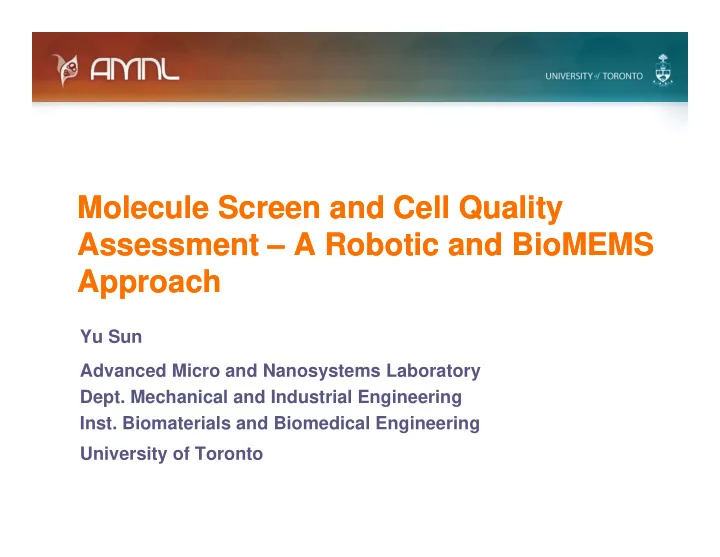

Molecule Screen and Cell Quality Molecule Screen and Cell Quality Assessment Assessment Assessment Assessment – A Robotic and A Robotic and BioMEMS A Robotic and BioMEMS A Robotic and BioMEMS BioMEMS Approach Approach Yu Sun Advanced Micro and Nanosystems Laboratory Dept. Mechanical and Industrial Engineering Inst. Biomaterials and Biomedical Engineering University of Toronto University of Toronto
Microrobotic Cell Manipulation • Slow • Low success rate • Low cell survival rate • Long learning curve • Inter-operator variability • Skill dependent • Skill dependent • Molecule testing • Molecule testing • Enucleation • Polar body biopsy • Polar body biopsy • Clinical ICSI 2
Cell Microinjection • Limited speed and reproducibility – Search & immobilize: random – manual switch: slow – orient: trial-error; slow; poor orient: trial error; slow; poor controllability – speed: 2 cells/min speed: 2 cells/min • Targets – speed: 12 cells/min p – rapid cell immobilization and Sun and Nelson, Sun and Nelson, IJRR IJRR , Vol. 21 , Vol. 21 (2002) (2002) orientation – high success/survival rates – grad students can do the work 3
Cell Holding Devices 4 Three devices every two days Biomed. Microdevices , Vol. 11, 2009
Fast Cell Immobilization • Pressure: 1.6~2.2kPa (mouse zygotes) • Immobilization time: 10~16sec (5 × 5 array) 5
Vision-Based Contact Detection 6 48 5 x coordinate (pixel) 4 46 3 2 44 pixel method 1 sub-pixel method fitted-sub-pixel method p 42 P S 50 100 150 200 Wang, Liu, and Sun, Wang, Liu, and Sun, Int. J. Robotics Research Int. J. Robotics Research , Vol. 26 (2007) , Vol. 26 (2007) 6
Microrobotic Cell Injection 7
Microrobotic Cell Injection 8 video speed: 1X video speed: 1X
Cell Orientation Control 9
Cell Orientation Control 10
System Control Architecture • Image space task planner • Looking then moving • On-line coordinate transformation 11
System Performance • Mouse embryo preparation – ICR mice (8~12 weeks) – PSMG and hCG injection (48hr) PSMG and hCG injection (48hr) – timed pregnancy (12hr) – embryo collection: ~20 cells/mouse • System optimization (n=306) mouse dissection – injection speed: 200 m/sec 4.5 day post-injection – retraction speed: 500 m/sec t ti d 500 / – injection pressure: 40~45kPa • PBS injection (n=240) • PBS injection (n=240) – speed: 12 cells/min (2 cells/min) – success rate: 98.9% (90%) – survival rate: 89.8% (80%) mouse blastocysts 12
Results – Mitochondrial Protein Testing success rates survival rates 100 100 100 85 6 ± 3 7% 85.6 ± 3.7% 82 8 ± 2 4% 82.8 ± 2.4% 79.8 ± 3.6% 79 8 ± 3 6% 80 74.1 ± 2.5% 80 e (%) (%) 60 51 1 ± 4 9% 49 ± 4 8% 51.1 ± 4.9% 49 ± 4.8% ~50% ~50% 60 60 success rate survival rate 40 40 n=400 n=400 n=100 20 20 n=273 n 273 n 273 n=273 n=307 n 307 n=302 n 302 20 20 0 0 automated automated manual KSOM control HTF control HTF + buffer HTF + protein buffer injection protein injection protein injection Nature Biotechnology , under review, 2010 13
Vision-Based Force Measurement • PDMS cell holding device and a sub-pixel PDMS ll h ldi d i d b i l visual tracking algorithm • Post deflections injection forces Post deflections injection forces 14
Force Analysis ( a ) ( b ) f f i vi p d d hi 1 1 30 a f hi d F 2 • Linear elasticity validation: Linear elasticity validation: max <11.1 <11 1º 3 i F 4 4 3 3 2 2 2 2 40 40 a ( ( 1 1 )( )( 2 2 H H a ) ) 8 8 ( ( a 8 8 H H a 6 6 H H a ) ) i 1 i i i i i 2 4 9 ED 3 ED 15
Distinguish Normal/Defective Oocytes • ICR young (n=20) and old (n=20) mouse oocytes • Stiffness: slope of force-deformation curve • Overlap: 4.4-4.8 nN/ m 240 240 6.4 ± 1.3 nN/ m young oocytes urve (nN/ m) old oocytes 8 200 (nN) 160 I II 6 6 ce-deformation cu ndentation force 3.3 ± 0.9 nN/ m 120 4 80 slope of forc i 2 40 0 0 0 4 8 12 16 20 24 young oocytes old oocytes cell deformation ( m) Lab Chip , to appear in 2010 16
Zona Pellucida (ZP) Structure Analysis surface morphology (SEM) glycoprotein density (TEM) glycoprotein density • ZP1-3: low expression in old oocytes ( Hum. Mol. Genet., 2004) 2004) 17
F-Actin Content Analysis • Phalloidin-FITC staining of F-actin F-actin content 3 0 3.0 2.5 6 ) t ( 10 2.0 e fluorescent unit 1.5 1.0 relative 0.5 n=12 n=10 0.0 180 180 young oocytes old oocytes 120 120 Y) 150 Y) 150 image coordinate (Y image coordinate (Y 100 100 120 120 80 80 • Krt8 and Myo10: low 90 90 60 60 expression in old oocytes 60 60 40 40 30 30 ( H m Mol Genet ( Hum. Mol. Genet., 2004) 2004) 20 20 20 20 30 60 90 120 150 180 30 60 90 120 150 180 image coordinate (X) image coordinate (X) 18
Summary • Synergy: microrobotics and bioMEMS • Microrobotic cell injection Microrobotic cell injection – Enabled molecule testing and MEL gene prioritization prioritization • In situ distinguish healthy and aged mouse oocytes to assess cell quality for cell oocytes to assess cell quality for cell selection 19
Recommend
More recommend